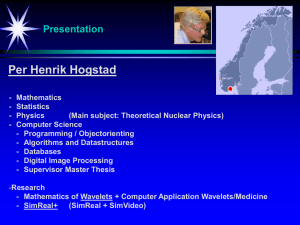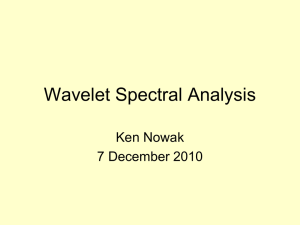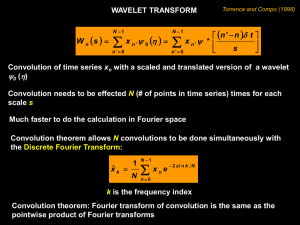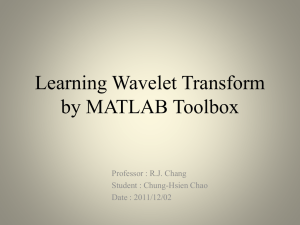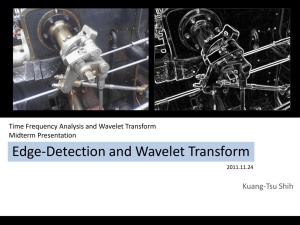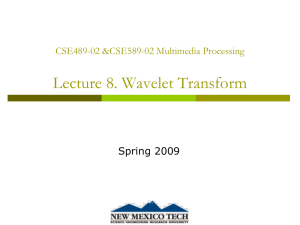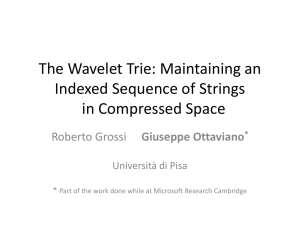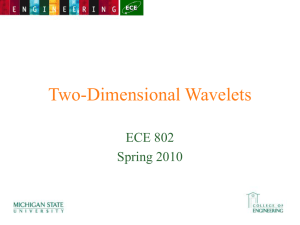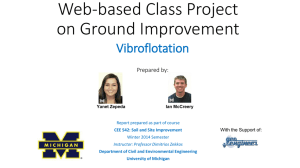Wavelet Transformation
advertisement
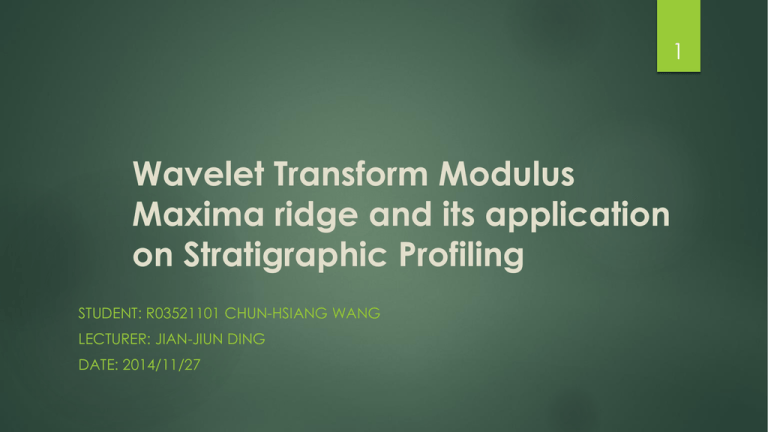
1 Wavelet Transform Modulus Maxima ridge and its application on Stratigraphic Profiling STUDENT: R03521101 CHUN-HSIANG WANG LECTURER: JIAN-JIUN DING DATE: 2014/11/27 Outline Introduction Wavelet Transformation Wavelet Zoom Wavelet Transform Modulus Maxima Application-Stratigraphic profiling SBT of CPT Demonstration - Simulative case Demonstration – Real case Conclusion 2 Outline Introduction Wavelet Transformation Wavelet Zoom Wavelet Transform Modulus Maxima Application-Stratigraphic profiling SBT of CPT Demonstration - Simulative case Demonstration – Real case Conclusion 3 Introduction 4 Why we need Wavelet Transform? Time Frequency Analysis Wavelet Short-time Fourier Transform Wavelet Transform Time & Frequency Transition & Scaling Characteristic of Frequency Distinguish local property Outline Introduction Wavelet Transformation Wavelet Zoom Wavelet Transform Modulus Maxima Application-Stratigraphic profiling SBT of CPT Demonstration - Simulative case Demonstration – Real case Conclusion 5 Continuous Wavelet Transform 6 Wavelet Transform = Dilation + Translation Translation ( t ) dt 0 1 tu D u , s ( t ) s s Dilation CWT: W f (u , s ) f (t ) tu s s 1 * dt |u R , s R → Convolution Form CWT-cont. 7 Basis characteristics if u , s ( t ) is a wavelet basis, then 1. 2. 3. 0 (t)d t 0 (t) (t)dt ( t ) * ( ) 2 d 2 1 CWT-cont. 8 Famous Wavelet Basis Type 0.25 0.5 Mexican hat Differential Gaussian function 0.2 DerGaussian 0.4 Mexican Hat 0.15 0.3 0.1 0.05 0.2 0 0.1 -0.05 -0.1 0 -0.15 -0.1 -0.2 -0.25 -10 -5 0 t (s) 5 10 -0.2 -10 -5 0 t (s) 5 10 CWT-cont. 9 DerGaussain function as example 0.4 0.4 u=0, s=0.02 u=0.1, s=0.02 u=0, s=0.02 u=0, s=0.04 0.3 0.3 0.2 0.2 0.1 0 t (s) t (s) 0.1 -0.1 -0.1 -0.2 -0.2 -0.3 -0.4 -2 0 -0.3 -1.5 -1 -0.5 0 0.5 1 1.5 2 Wavelet Zoom Focus on localized signal structures with a zooming procedure that progressively reduces the scale parameter 10 Lipschitz Regularity A function f is pointwise Lipschitz at v , if there exists K , and a polynomial p v of degree m such that, t , f (t ) p v (t ) K t v 11 The Lipschitz regularity of f at v or over [ a , b ] is the least upper bound of the such that f is Lipschitz . Lipschitz Regularity-Example Lipschitz alpha =0 12 Lipschitz alpha =1 5 3 4.5 2.5 4 3.5 3 Amptitude Amptitude 2 1.5 Jump 1 2.5 Cusp 2 1.5 1 0.5 0.5 0 0 1 2 3 4 5 t (s) 6 7 8 9 10 0 0 1 2 3 4 5 t (s) 6 7 8 9 10 Vanishing moment A wavelet with a fast decay has n vanishing moments iff there exists with a fast decay such that, t ( t ) dt 0, k [0, n ) k Ψ(t) with n vanishing moments can only “see” a change point with Lipschitz regularity α that is less than n. 13 Wavelet Transform Modulus Maxima(WTMM) WTMM = ridge ( u , s ) [a, b] , W f ( u , s ) A s 1 2 1 log W f ( u , s ) log A log( s ) 2 ( The dip of equation of this ridge is 0.5 definitely. jum p , 0) 14 WTMM-cont. 15 Outline Introduction Wavelet Transformation Wavelet Zoom Wavelet Transform Modulus Maxima Application-Stratigraphic profiling SBT of CPT Demonstration - Simulative case Demonstration – Real case Conclusion 16 Geotechnical Engineering 大地工程 Soil mechanics Rock mechanics, Tunnel Engineering Soil Dynamics, Geotechnical Earthquake Engineering Engineering Geology, Fault Detecting Foundation Engineering, underground Excavation …… 疇凡 !是 地 下 的 工 程 議 題 都 是 大 地 有 關 範 17 Cone Penetration Test 圓錐貫入試驗 In-situ Test Main Measurement Cone Resistance,qc Friction Sleeve,fs Pore Water Pressure,u2 18 Target Site investigation P.K. Robertson, 1990 Soil Behavior Type(SBT) 19 P.K. Robertson,1998 Fr fs qv v0 Q tn q t v 0 ' Pa Pa v 0 1. 2. 3. 4. 5. 6. 7. 8. 9. Sensitive, fine grained Organic soils (peats) Clays (clay to silty clay) Silt mixtures (clayey silt to silty clay) Sand mixtures (silty sand to sandy silt) Sands (clean sand to silty sand) Gravelly sand to sand Very stiff sand to clayey sand Very stiff, fine grained Ic imply SBT 20 P.K. Robertson, 1998 𝐼𝑐 = 3.47 − 𝑄𝑡𝑛 2 + 1.22 + 𝐹𝑟 2 SBT Description Ic < 1.31 Gravelly sand to dense sand 1.31< Ic < 2.05 Sands: clean sand to silty sand 2.05< Ic < 2.60 Sand mixtures: silty sand to sandy silt 2.60< Ic < 2.95 Silt mixtures: clayey silt to silty clay 2.95< Ic < 3.60 Clays: silty clay to clay Ic > 3.60 Organic soil Insight of Soil Layers location at which the soil behavior type index changes abruptly 0 2 4 SBT 6 SBT 3 6 But in reality…… There will be some noise definitely! Depth z (m) 21 8 10 12 14 16 18 20 -2 0 2 Ic(z) 4 6 Transition Zone 22 Cone can sense a layer boundary up to a distance of 15 cone diameters ahead and behind. That will make us more difficult to identify layers ! Outline Introduction Wavelet Transformation Wavelet Zoom Wavelet Transform Modulus Maxima Application-Stratigraphic profiling SBT of CPT Demonstration - Simulative case Demonstration – Real case Conclusion 23 Simulated Case Demonstration 0 0 2 B C -0.5 A 4 A -1 8 logWI C(u,s) Depth z (m) 6 B 10 12 -1.5 -2 -2.5 14 -3 16 C -3.5 18 20 1 2 3 I c(z) 4 -4 -1.5 -1 -0.5 log(s) 0 0.5 24 In-situ Case Demonstration-NGES Taxes A&M University (National Geotechnical Experimentation Site,1993) 25 NGES-cont. 26 NGES-cont. 27 More difficult case Oslo Main airport station 28 Oslo in-situ case-cont. 29 Outline Introduction Wavelet Transformation Wavelet Zoom Wavelet Transform Modulus Maxima Application-Stratigraphic profiling SBT of CPT Demonstration - Simulative case Demonstration – Real case Conclusion 30 Conclusion WTMM is widely applied to detecting discontinuity, like jump or cusp, in nowaday engineering. Using a series of scale, or narrowing windows, we can grab the characteristic of a signal at some one local position. It’s used to bore one or several holes at a construction site for investigation the stratigraphic property. If we enforce CPT and WTMM in field investigation, it will be more efficient and economical. 31 Conclusion-cont. In Taiwan we usually take USCS as main principle of soil classification but not SBT of CPT. However, it must take lots of time and manpower if we still take USCS. SBT of CPT has a clear and concise image of civil engineering application, because of the clear distinguishing principle of sand and clay. It will help us to realize a better design in engineering. 32 Reference 33 P.K. Robertson, C.E. Wride, Evaluating cyclic liquefaction potential using the cone penetration test, 1998 P.K. Robertson, Interpretation of cone penetration tests — a unified approach, 2009 B. S. Chen, P.W. Mayne, Profiling the overconsolidation raito of clays by Piezocone tests, 1994 Y. Wang, Probabilistic identification of underground soil stratification using cone penetration tests, 2013 J. Benoît, A. J. Lutenegger, National Geotechnical Experimentation Sites, 1993 Mallat, A Wavelet Tour of Signal Processing, 2008 34 Thanks for your listening!
